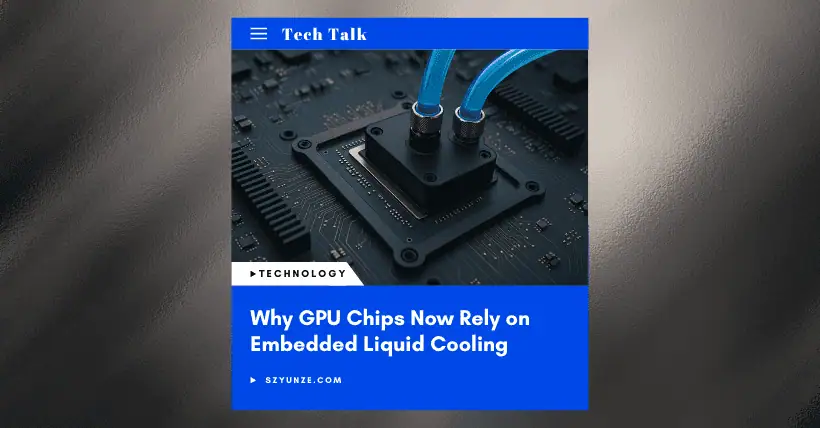NVIDIA chips require embedded liquid cooling technology mainly to address the demanding thermal and energy efficiency requirements of artificial intelligence (AI) and high-performance computing (HPC) workloads. As GPU computing density and power consumption continue to rise, traditional air-cooling solutions can no longer meet the cooling demands. For example, the power consumption of NVIDIA’s H100 and H200 GPUs can exceed 1500W, making it difficult for conventional air cooling systems to effectively dissipate heat.
Embedded liquid cooling technology integrates microchannel cooling blocks directly into the chip package, closely coupling the heat source with the cooling medium, significantly reducing thermal resistance and improving cooling efficiency. For instance, JetCool’s SmartPlate for the NVIDIA H100 GPU uses single-phase direct-to-chip liquid cooling technology with a low thermal resistance of 0.021°C/W, supporting cooling power up to 1500W.
In addition, embedded liquid cooling offers advantages such as reduced energy consumption, lower noise, and space savings. For example, a liquid-cooled AI development platform jointly developed by Supermicro and NVIDIA can reduce power usage by up to 40% while improving AI workload efficiency.
01
What is Embedded Liquid Cooling?
Embedded liquid cooling integrates the liquid cooling system “into” the chip or package itself, instead of attaching a heatsink externally as in traditional setups. Specifically, it involves integrating a microchannel cooling block on the CPU package (IHS or directly on the package shell), allowing liquid to flow through these microchannels and carry away heat directly from hot spots. This approach minimizes thermal resistance between the heat source and the cooling medium.
Intel has showcased a prototype at its Foundry Direct Connect event: a copper microchannel cooling block directly mounted on the CPU package top, combined with a liquid metal or solder TIM layer, achieving cooling power of up to 1000 W, with 15‑20% higher efficiency compared to traditional delidded water-cooling systems.
02
Core Components and Implementation
- Microchannel Cooling Block
Fabricated in copper or high thermal conductivity materials via precision etching or machining to form microchannels.
The fluid directly targets the hot spot regions along the path of lowest thermal resistance, enabling more precise and efficient cooling.
- Thermal Interface Materials (TIM)
Liquid metal or solder is used instead of traditional thermal grease to ensure tighter contact between the top of the package and the cooling block, reducing interface thermal resistance and improving heat transfer efficiency. - Packaging Integration Method
This cooling structure is typically designed to be compatible with LGA or BGA packaging. Once installed, it becomes part of the package, eliminating the need for bulky external heatsinks.
It effectively meets cooling needs for high thermal density applications in future AI, HPC, and server workstations.
03
Advantages
Minimal thermal resistance: Shorter, more direct thermal path with only one TIM layer between package and coolant.
Precisely targets hotspots: Channel layout can be designed based on internal chip hotspot distribution (e.g., high-power cores), enhancing localized cooling efficiency.
Supports tighter power density: Ultra-thin cooling block supports highly integrated, high-power chip designs.
Smaller overall system size: No need for traditional large heatsinks or AIO water coolers—cooling unit is built into the package itself.
04
Limitations and Challenges
- Process and Manufacturing Complexity
Integrating a microchannel water-cooling structure into the package top is technically demanding, requiring high precision, careful material selection, and strict fluid sealing.
It also demands tight collaboration and customization from the packaging design stage.
- Fluid and Bubble Management
When flow or temperature reaches the two-phase zone (boiling area), bubbles can form, disrupting flow paths and impairing heat exchange.
Microchannel geometry, inlet pressure, and flow rate must be precisely controlled to prevent vapor lock, uneven boiling, and local dry-out.
- System Design and Reliability
Excessive flow rate inside the package may lead to pressure loss, structural vibration, or even leakage.
The TIM, copper block, and package bonding interfaces must remain stable and heat-cycle-resistant over the long term to prevent fatigue failure.
05
Overall Technical Process (Systematic Overview)
| Stage | Content | Key Notes |
|---|---|---|
| Design Stage | Collaboration of chip, packaging, and thermal design | Plan microchannel layout based on CPU/GPU hotspot distribution |
| Manufacturing Stage | Integration of microchannel cooling block into the package | Use copper or high thermal conductivity materials via micro-machining or embedding |
| Contact Layer Treatment | Liquid metal or solder TIM | Improve interface thermal conductivity and reduce traditional interface resistance |
| System Integration | Tubing, pump, and flow rate control | Control flow pressure and temperature to prevent uncontrolled bubbles |
| Testing Stage | Thermal performance and reliability testing | Includes thermal cycling, shock, pressure, and leak tests |
| Application Stage | Deployment in high-power AI and HPC servers | Applicable to Xeon, Core Ultra, and other similar packages |
06
One-Sentence Summary
Embedded liquid cooling integrates a “miniature copper water-cooling block” directly into the chip package, using a liquid metal TIM layer to tightly couple the package with the coolant, shortening the thermal path to the minimum and enabling up to 1000 W of cooling power—an innovative cooling technology designed for high thermal density chips, though it demands advanced manufacturing, fluid control, and long-term reliability.

Disclaimer:
- This channel does not make any representations or warranties regarding the availability, accuracy, timeliness, effectiveness, or completeness of any information posted. It hereby disclaims any liability or consequences arising from the use of the information.
- This channel is non-commercial and non-profit. The re-posted content does not signify endorsement of its views or responsibility for its authenticity. It does not intend to constitute any other guidance. This channel is not liable for any inaccuracies or errors in the re-posted or published information, directly or indirectly.
- Some data, materials, text, images, etc., used in this channel are sourced from the internet, and all reposts are duly credited to their sources. If you discover any work that infringes on your intellectual property rights or personal legal interests, please contact us, and we will promptly modify or remove it.



